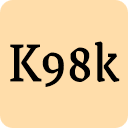Are you saying that always exactly same dies were used on receiver/barrel and on smaller parts? Do I understand you correctly?
No, but they all tended to be in the same font, for lack of a better term, and different factories ended up with slightly different but internally consistent looks to their numbers. There's absolutely a Mauser font, for example, and if you spend enough time looking at these you'll start to get a feel for it.
Here are two examples that illustrate a bit of what I'm talking about. The first is an 1917 WMO Gew98. Some of those numbers are slightly different sizes, so they'd use different dies, and even with the ones that are the same size if nothing else you're not going to have one dude walking around with a single set of punches numbering every rifle in the factory.
Picked this rifle up from a good collector friend of mine last weekend at NGD. He bought this piece many years ago and being I collect German WW1 Imperial he thought this piece would better suit me. When he first told me about it, he just said he had a Gew98 for sale didn't tell what maker till...

www.k98kforum.com
Pay attention to how the #2 is shaped on that rifle.
Now here is a 1916 JP Sauer gun . Same basic idea, look at how the numbers all have the same basic shape. Look at the 3's in particular, that's another number that frequently has subtly different shapes. Now compare the 2's in this gun to the 2's in the WMO above. See how the curve at the top of the WMO #2 is a bit different, and the curved bit up top is a slightly different size and with a slightly different angle than the Sauer? That's what I'm talking about.
I've been away from the forum for quite a while however recently I began lurking here again. Last Thursday a guy came into my store carrying the J.P. Sauer & Sohn Gewehr 98 shown here. His grandfather had given him the rifle 25 years ago and two things became apparent while talking to him...

www.k98kforum.com
The numbers that this shows up the most on are anything with a big curve or a prominent cross piece. So 2, 3, 4, and 5 are all really good for spotting these differences. 3 and 2 especially. You'll also sometimes get differences in the size of circular bits relative to the rest of the number, so 6, 8, and 9.
edit: the fonts also change over time. The very early WMO fonts are a lot more "script" like, for lack of a better term. Here's an 1899 WMO and the font is significantly different form the 1917 linked above. It's not a numbers matching gun but pay attention to the parts that do match, and again look at the #2 in particular in comparison to the later WMO above.
Hi guys, This one came home with me from the Baltimore show back in March. Another member here gave me advance notice that he might be selling, so I asked him to hold it for me under his table. This one has seen its share of action, and many signs of reworking, but still presents well. The...

www.k98kforum.com
It's one of those things where if you look at enough guns you get a feel for it and how it changes over time. If you think this is bad, the people who do WW2 rifles have been able to spot stuff like when a particular proof die at Mauser was broken in, I believe, late 1944.






